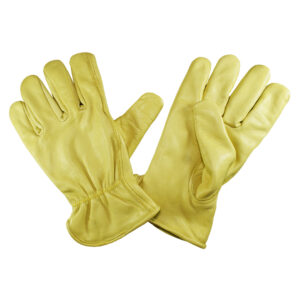
Leather safety gloves are still a popular option for many industrial applications in 2025 and are still quite important. Leather’s special blend of qualities guarantees its continuous significance in hand protection, even though more contemporary substitutes have appeared. This conversation will only address the long-term value and unique benefits of leather safety gloves.
Durability and Longevity:
Excellent durability and resistance to deterioration are provided by leather, particularly premium hides like goatskin and cowhide. Leather gloves can tolerate a great deal of wear in harsh industrial settings, which makes them an affordable option over time. Because of their durability, they are less likely to be harmed by abrasive materials, sharp edges, and frequent use, in heavy-duty applications, they frequently outlast certain synthetic counterparts.
Abrasion and Puncture Resistance:
High levels of protection against abrasions and punctures are offered by leather’s natural toughness. Leather gloves provide a dependable barrier for jobs involving the handling of gritty materials, splinters, and somewhat sharp things. Leather offers a fair general level of resistance for a variety of applications, but specialized cut-resistant gloves built from materials like Kevlar or Dyneema excel in particular cut risks.
Heat Resistance:
Leather possesses natural heat-resistant properties, making it suitable for applications involving moderate heat exposure, such as welding (especially split leather), foundry work, and handling warm materials. While aluminized or specialized high-heat-resistant gloves are necessary for extreme temperatures, leather offers a practical level of thermal protection for many industrial tasks.
Dexterity and Comfort:
The degree of dexterity offered by various leather kinds varies. For example, goatskin is renowned for its tactile sensitivity and suppleness, which makes it appropriate for activities demanding finer motor skills while also offering protection. Once broken in, even thicker cowhide gloves can provide a flexible and comfortable fit that gradually improves grip and lessens fatigue. By promoting air circulation and minimizing perspiration accumulation within the glove, leather’s inherent breathability also enhances comfort. Sourcing high-quality leather hand gloves from a reputable leather hand gloves supplier in India can ensure that you get the best combination of protection, dexterity, and comfort for your specific needs.`
Grip:
Leather offers a naturally good grip, which can be further enhanced by surface treatments or textured finishes. This secure grip is crucial for safely handling tools and materials in various industrial settings, reducing the risk of slippage and accidents.
Specific Applications Where Leather Thrives:
- Welding: Split leather gloves are a staple in welding due to their heat resistance and durability against sparks and molten metal.
- Construction and Rigging: Robust cowhide gloves provide excellent abrasion and tear resistance for handling rough materials and equipment.
- Manufacturing and Assembly (General): Depending on the specific task, both cowhide and goatskin offer a balance of protection and dexterity.
- Material Handling: Leather gloves provide a reliable grip and protection against abrasions when moving various materials.
- Cold Weather: Leather gloves, especially those with linings, offer good insulation and protection against cold environments.
Limitations of Leather Gloves (Acknowledging the Broader Context, but Focusing on Leather Itself):
While leather remains relevant, it’s important to acknowledge its inherent limitations:
- Water Resistance: Leather is not naturally waterproof and can stiffen or lose its protective qualities when exposed to excessive moisture. While treatments can improve water resistance, it’s generally not the primary choice for consistently wet environments.
- Chemical Resistance: Leather offers limited resistance to many chemicals, oils, and solvents. For tasks involving hazardous substances, specialized chemical-resistant gloves made from nitrile, neoprene, or other synthetic materials are necessary.
- Cut Resistance (Extreme): For tasks with a high risk of severe cuts, specialized high-performance cut-resistant gloves often surpass the inherent cut resistance of standard leather.
Conclusion on Leather’s Relevance:
Despite the emergence of modern alternatives, leather safety gloves continue to hold a significant place in industrial hand protection in 2025. Their unique combination of durability, abrasion resistance, moderate heat resistance, potential for good dexterity and grip, and natural comfort ensures their ongoing relevance across a wide range of applications. Protective leather gloves are particularly valued for their ability to provide reliable defence against various workplace hazards. While specific hazards might necessitate alternative materials with superior chemical or cut resistance, leather remains a reliable and often preferred choice for its overall performance and longevity in numerous demanding work environments. Manufacturers continue to innovate with leather treatments and designs to further enhance its protective qualities and address some of its inherent limitations.








